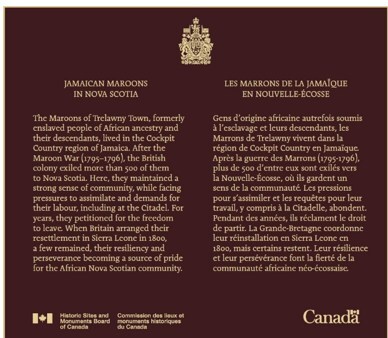HALIFAX,
NS, Aug. 1, 2024 /CNW/ - Today,
Lena Metlege Diab, Member of Parliament for Halifax West,
commemorated the national historic significance of the Jamaican
Maroons in Nova Scotia with a special ceremony to unveil a
plaque at Halifax Citadel National Historic Site. The
announcement was made on behalf of the Minister of Environment and
Climate Change and Minister responsible for Parks Canada,
Steven Guilbeault.

In April 1796, more than 500
Maroons from Trelawny Town in the
mountains of northwestern Jamaica were forcibly transported to
the British colony of Nova Scotia.
Their experiences exemplified the insecure rights and freedoms of
African-descended British subjects in the
late-18th-century Atlantic world. The Maroons of
Trelawny Town were formerly enslaved peoples of African ancestry
and their descendants who had lived in the Cockpit Country region
of Jamaica until their exile
following the second and final Maroon War (1795–1796). Almost
everyone from the town—approximately 150 families or more than 500
adults and children—were forcibly transported to Nova Scotia. Many people became sick and
several died during the voyage.
The Maroons moved a few months after they arrived to lands in
Preston township purchased with
funds from the Jamaican government. There, they faced considerable
pressures to convert to Christianity, adopt settler agriculture,
and undertake hard manual labour for low wages. They contributed to
the building of roads, highways, canals, bridges, buildings, and
fortifications in Nova Scotia,
including the third fortification on Citadel Hill in Halifax, which was later replaced by the
fourth and final Halifax Citadel (designated a national historic
site in 1935). To reflect this direct connection, the Halifax
Citadel National Historic Site was chosen as the location for the
commemorative plaque.
For years, the Maroons tirelessly petitioned for the freedom to
leave Nova Scotia. In the end, the
British arranged for their migration to Sierra Leone, and 177 women, 151 men, and 222
children were aboard the transport ship HMS Asia when it anchored off the coast of
Freetown on 30 September 1800.
A small number of Jamaican Maroons remained in Nova Scotia. The pride, resistance,
self-determination, and unique cultural identity of the Maroons
gained new significance in the second half of the 20th
century within the contexts of social movements for greater civil
rights and recognition of the diverse histories, cultures, and
achievements of African-descended peoples. Today, the historical
presence of the Jamaican Maroons still holds a prominent place
within the collective memory of African Nova Scotians.
The Government of Canada,
through the Historic Sites and Monuments Board of Canada, recognizes significant people, places,
and events that shaped our country as one way of helping Canadians
and youth connect with their past. The designation process under
Parks Canada's National Program of Historical Commemoration is
largely driven by public nominations. To date, more than 2,240
designations have been made nationwide.
National historic designations illustrate the defining moments
in the story of Canada. Together,
they tell the stories of who we are and connect us to our past,
enriching our understanding of ourselves, each other, and our
country. Heritage places provide a wide range of cultural, social,
economic, and environmental benefits to their
communities.
Today's ceremony coincides with Emancipation Day, the day the
Slavery Abolition Act of 1833 came into effect in the
British Empire and ended the practice of slavery for millions of
African People and their descendants around the world (August 1, 1834). The unveiling is one part of a
larger event to honour and commemorate this important day alongside
the Office of African Nova Scotian Affairs, the Canadian Museum of
Immigration at Pier 21, the Black Cultural Centre for Nova Scotia, and the Jamaican Cultural
Association of Nova Scotia.
Quotes
"On behalf of the Government of Canada, I am honoured to join Parks Canada in
commemorating the national historic significance of the Jamaican
Maroons in Nova Scotia. Their
experiences, dignity, strength, resiliency, and resistance to
oppression live on as a lasting legacy in this province. Historic
designations reflect Canada's rich
and varied history, and I encourage all Canadians to learn more
about the Jamaican Maroons and their important contributions to
Canada's heritage."
Lena Metlege
Diab
Member of Parliament for Halifax West
Quick Facts
- In 2022, the Jamaican Maroons in Nova
Scotia were officially designated as an event of national
historic significance under Parks Canada's National Program of
Historical Commemoration.
- The Jamaican Maroons were formerly enslaved peoples of African
ancestry and their descendants who had lived in relative
independence and isolation in Trelawny Town, Jamaica.
- The experiences of the more than 500 Jamaican Maroons forcibly
transported to Nova Scotia in 1796
exemplified the insecure rights and freedoms of African-descended
British subjects in the late 18th century.
- While most of the Maroons left for Sierra Leone, some individuals remained in
Nova Scotia. Their continued
presence is reflected in the surnames, accents, idioms, customs,
oral histories, and traditions of African Nova Scotians, for whom
Maroon dignity, strength, resiliency, perseverance, and resistance
to oppression are a continued source of pride.
- Created in 1919, the Historic Sites and Monuments Board of
Canada advises the Minister of
Environment and Climate Change regarding the national historic
significance of persons, places, and events that have marked
history in Canada. Together with
Parks Canada, the Board ensures that subjects of national historic
significance are recognized, and these important stories are shared
with Canadians.
- The vast majority of nominations brought forward for the
consideration of the Historic Sites and Monuments Board of
Canada originate from members of
the public. To nominate a person, place or historical event in your
community, please visit the Parks Canada website for more
information:
https://www.pc.gc.ca/en/culture/clmhc-hsmbc/ncp-pcn/application.
Related Document
Backgrounder – The Jamaican Maroons in Nova Scotia
Related Links
Parks Canada
Historic Sites and Monuments Board of Canada
Framework for History and Commemoration
SOURCE Parks Canada (HQ)